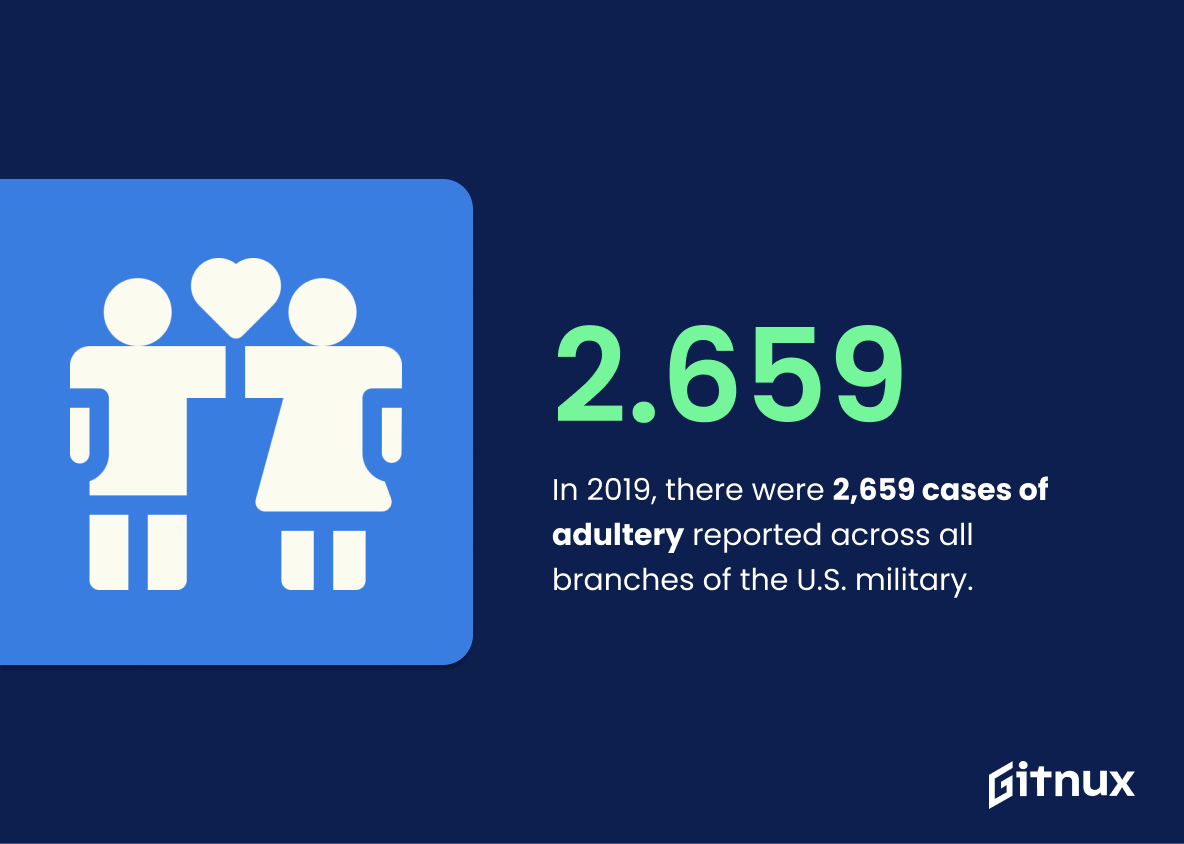Adultery is a serious offense in the military, and it can have significant consequences for those who are found guilty. This blog post will explore some of the statistics related to adultery in the military, including rates of infidelity among service members, differences between genders and branches of service, punishments associated with adultery convictions, and more. We’ll also look at how attitudes towards adultery have changed over time within the U.S. Armed Forces.
Adultery In The Military Statistics Overview
In 2019, there were 2,659 cases of adultery reported across all branches of the U.S. military.
This statistic is a stark reminder of the prevalence of adultery in the U.S. military. It highlights the need for further investigation into the causes of this behavior and the implementation of measures to prevent it from occurring. It also serves as a warning to those considering engaging in such activities, as the consequences can be severe. This statistic is an important part of understanding the scope of the issue and the steps that need to be taken to address it.
An estimated 70% of military marriages involve at least one infidelity.
This statistic is a stark reminder of the prevalence of infidelity in military marriages. It highlights the need for greater awareness and understanding of the issue, as well as the need for more resources to help couples navigate the challenges of maintaining a healthy relationship while in the military.
According to Ashley Madison’s 2017 survey, the Army is the military branch with the highest rate of adultery, with 42% of those surveyed admitting to having cheated.
This statistic is a powerful indicator of the prevalence of adultery in the military, particularly in the Army. It serves as a stark reminder of the potential consequences of infidelity in the armed forces, and the need for greater awareness and education on the issue. It also highlights the importance of providing support and resources to those affected by adultery in the military, and the need for better policies and procedures to address the issue.
In 2013, the Marine Corps recorded 101 cases of adultery, with 61 court-martials and 47 nonjudicial punishment cases.
This statistic is a telling indication of the prevalence of adultery in the military. It shows that even in 2013, a significant number of cases of adultery were recorded, with a majority of them resulting in court-martials or nonjudicial punishments. This statistic is a stark reminder of the need for the military to take a firm stance against adultery and to ensure that it is not tolerated.
In 2014, the U.S. Air Force reported 69 courts-martial and 191 nonjudicial punishment cases related to adultery.
This statistic is a powerful indicator of the prevalence of adultery in the U.S. Air Force in 2014. It shows that, despite the military’s strict regulations against adultery, it is still a problem that needs to be addressed. This statistic is important to consider when discussing the issue of adultery in the military, as it provides a tangible example of the scope of the issue.
In 2010, 71% of military professionals considered adultery as a valid basis for dismissal from the service.
This statistic is a powerful indicator of the prevailing attitude towards adultery in the military. It shows that the majority of military professionals take a serious stance on the issue, recognizing it as a valid reason for dismissal. This statistic is an important piece of information for anyone looking to gain a better understanding of the military’s stance on adultery.
In 2009, a survey revealed that 38% of military members attributed the end of their marriage to infidelity that occurred during deployment.
This statistic is a powerful indicator of the impact of adultery in the military. It shows that infidelity during deployment can have a devastating effect on marriages, with nearly four out of ten military members citing it as the cause of their divorce. This statistic is an important reminder of the potential consequences of adultery in the military and should be taken into consideration when making decisions about relationships.
In 2017, the Uniform Code of Military Justice significantly narrowed the definition of adultery, reducing the number of cases that could be pursued under Article 134.
This statistic is of great importance when discussing Adultery In The Military Statistics, as it demonstrates the impact of the Uniform Code of Military Justice on the prevalence of adultery in the military. By narrowing the definition of adultery, the number of cases that could be pursued under Article 134 was drastically reduced, indicating a shift in the military’s stance on the issue.
Adultery can still lead to various penalties in the military, including loss of pay and benefits, confinement or even dishonorable discharge.
This statistic is a stark reminder of the serious consequences that can befall those who engage in adultery while in the military. It serves as a warning to those who may be considering such an action, and highlights the importance of maintaining a professional and ethical code of conduct while serving in the armed forces.
The U.S. Military Academy at West Point reported at least 30 cases of adultery among cadets and staff from 2011 to 2014.
This statistic serves as a stark reminder of the prevalence of adultery among cadets and staff at the U.S. Military Academy at West Point. It highlights the need for further investigation into the causes of this behavior and the implementation of measures to prevent it from occurring in the future.
Military members who commit adultery during deployment are at risk of being prosecuted under the Uniform Code of Military Justice, facing a maximum penalty of dishonorable discharge, forfeiture of all pay and allowances, and confinement for one year.
This statistic is a stark reminder of the consequences of committing adultery in the military. It serves as a warning to military members that engaging in such behavior can lead to serious repercussions, including the loss of their career and financial security. It is an important reminder that the military takes adultery seriously and will not hesitate to take action against those who violate its code of conduct.
Conclusion
Based on the statistics presented, it is clear that adultery in the military is a serious issue. While there are varying rates of infidelity among different branches and genders, overall it appears to be an endemic problem with significant consequences for those who engage in such behavior. The Uniform Code of Military Justice has taken steps to reduce cases of adultery by narrowing its definition but still imposes harsh penalties if found guilty. It is important for service members to understand these rules and regulations so they can make informed decisions about their relationships while serving their country.
References
0. – https://www.www.thebalancecareers.com
1. – https://www.www.militarytimes.com
2. – https://www.www.cbsnews.com
3. – https://www.taskandpurpose.com
4. – https://www.www.businessinsider.com
5. – https://www.www.military.com
6. – https://www.pubmed.ncbi.nlm.nih.gov
7. – https://www.www.marinecorpstimes.com
8. – https://www.www.rand.org
9. – https://www.katu.com
10. – https://www.www.today.com












